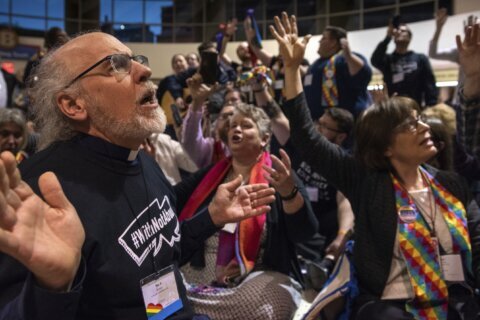WINDSOR, England (AP) — The silence was palpable when the imperial state crown was removed from the coffin of Queen Elizabeth II and placed on the altar of St. George’s Chapel — the first time in 70 years the dazzling symbol of Britain’s monarchy was separated from the sovereign.
My assignment covering a nation in mourning came down to parsing what those fleeting seconds has meant to this society, from the upper echelons of British nobility down to newly arrived migrants hoping to carve out a better life in a new country.
The 10 days I have spent here since Elizabeth’s death has taken me from Windsor Castle’s sumptuous interiors — the official residence of the royal family — to forgotten districts beyond the bustle of London, the glamorous British capital.
I’ve stood in line for hours with strangers devoted to the queen and desperate to say a final goodbye. Stood in the rain with thousands hoping to catch a glimpse of the hearse whizzing toward Buckingham Palace’s imposing gates. I’ve witnessed countless tears shed by young and old, from people as far away as South Africa to as nearby as the English city of Reading.
In the spaces between the devoted and the apathetic, I have encountered Britons who are ambivalent or undecided about the significance of the monarchy in their lives — or completely indifferent.
Diaspora communities, whose forefathers suffered under the brutalities of British colonialism, are still struggling to come to terms with that legacy. A younger generation of immigrants have not yet reconciled that violent history with their own identity as Brits. Some told me they see themselves as “Londoners” — identifying with the hip, cosmopolitan capital — but not “British,” part of the United Kingdom of which the monarch is the head of state.
I’ve also met people who downright don’t care.
Some planned weekend getaways to avoid the crowds swooning over the late monarch. A relentless barrage of Twitter memes have been poking fun at the queen’s demise.
Still, history weighed heavily inside St. George’s Chapel in Windsor on Monday, the day of Elizabeth’s funeral.
Founded in the 14th century by King Edward III, the ornate chapel has belonged to the monarchy for 1,000 years. It has been the scene of many royal events, from funerals to baptisms to royal weddings like that of Prince Harry and Meghan, the Duchess of Sussex.
Ornate stone craftsmanship draws the eye up to the ellipse-shaped roof, irreplaceable and meticulous woodwork lines the path toward the catafalque. Here, the chapter clerk of the chapel told a group of reporters how every step in the committal service, a more intimate gathering compared to the state funeral in Westminster Abbey, was plotted carefully by the queen.
Every hymn was her choice, except for the very last.
The removal of the crown was an extraordinary moment, the clerk explained. Though steeped in the spectacle of royal grandeur, it embodies a powerful moment of change: moving from head of sovereign’s coffin to the altar, only to return to the head of a new sovereign — King Charles III — when he is crowned.
Yet the vast majority of the country is not privy to the intimate details of the life of the late monarch they loved — they have spent their entire lives watching from afar.
“We couldn’t get as close as we wanted to see it properly,” said Rachel Mfundiri, who was still standing outside the castle’s imposing gates after Elizabeth was interred. She had come to witness history but now that it was over, she didn’t quite know quite where to go.
“It’s kind of unknown what happens next, to see how the monarchy changes,” she said, as the first raindrops of the day began to fall. “It’s sad, very sad.”
In London, it was business as usual.
Restaurants and bars were buzzing with tourists until the late hours. In one bar, a singer dressed in 1930s garb raised a glass — “to our lovely queen” she said, followed by, “but I can’t dedicate this next song to her.” She proceeded to belt out a George Michael tune as the audience cheered.
I found support for the late queen in unexpected places.
Inside London Central Mosque, an old photo of Elizabeth’s father, King George VI is plastered alongside bulletins announcing recent events.
The late king had opened the Islamic Cultural Center, now part of the grand mosque complex, in 1944, in recognition of Muslim efforts in fighting alongside the British Empire during World War II.
“We have always had strong links with the monarchy,” said Ayaz Zuberi, a spokesman for the mosque.
Even among Elizabeth’s ardent supporters, it was not possible to generalize their individual reasons for wanting to pay their respects to her years of service. For many it was personal: A family member had recently passed away, a deep sense of respect lingered.
Or, in Mili Patel’s case, wanting to show her young daughter the importance of the past.
Patel had folded up her lawn chair and was heading away from the lawns of the Long Walk, the processional route leading to Windsor Castle. She had come with her daughter Sybill, arriving at 5 a.m. and staying for 12 hours to see the queen — or at least her coffin — for the last time.
“It will be the last queen in (my daughter’s) generation,” she said. “I wanted her to see it.”
—-
Follow all AP stories on Britain’s royal family at https://apnews.com/hub/russia-ukraine.
Copyright © 2024 The Associated Press. All rights reserved. This material may not be published, broadcast, written or redistributed.







